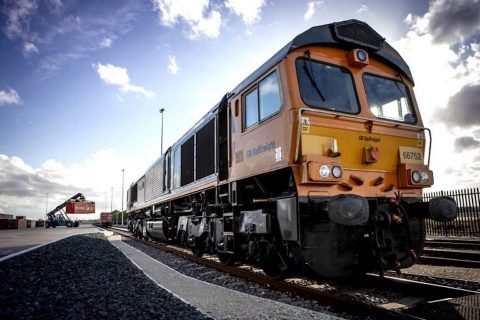No diesel locomotives but gliding trains for the new Dutch RTG terminal

The Dutch province of Gelderland and Infrastructure Manager ProRail are working on technology to allow the entry of freight trains onto the proposed Railterminal Gelderland (RTG) without overhead lines and the help of diesel locomotives. Instead, freight trains will ‘glide’ onto the terminal grounds, saving time and reducing CO2 emissions. Railfreight.com spoke to provincial project manager Patricia van Eijndthoven and her counterpart at ProRail Gerben Leskens about the plans.
The RTG would be the first site in the Netherlands to work with this technology, whereby freight trains would use the momentum gained on the Betuweroute freight line to roll onto the terminal with the electric locomotive. Rail freight terminals often do not have overhead lines, as this would complicate loading and offloading operations. Yet at the RTG, there is a section with overhead lines planned where the freight train will come to a halt. The sections are proposed for each end of the terminal “so that there is enough room elsewhere for loading and unloading”, Van Eijndthoven explains.
The technology is already used in Germany and Austria but not yet in the Netherlands. “It makes shunting operations at freight terminals a lot more efficient because by rolling onto the site, you eliminate the need to switch from an electric locomotive to a diesel unit before entering the yard and vice versa once loading and unloading operations are completed”, Leskens adds. “For this reason, we support this project and see it as a way forward for other terminals”.
Multiple gains
Van Eijndthoven sees additional benefits for the planned terminal in Valburg. “Reducing shunting operations saves time. Freight trains also have to break less, which eliminates noise. And because trains will no longer need to switch to diesel locs for shunting, operations will save a generous amount of CO2 emissions. In short, by incorporating the mentioned technology, we create a future-proof rail terminal that fits the larger European goal of making rail freight more efficient and greener”.
It also makes sense from an economic perspective, Van Eijndthoven adds. “Sure, constructing bits of overhead line requires a one-time investment, but eliminating the need for diesel locs comes with major and longer-term advantages for an operator”.
Technology ready by 2026
So how far along are ProRail and the provincial government in deploying this technology? “We are currently working on the specifics of the train protection system and to tie in the system used on the Betuweroute with that of the future terminal. You have to make sure everyone receives a timely notice of an incoming freight train and that you literally remove all obstacles”, Leskens explains. “This might not be the most visible part of the project, but it is one of the more vital elements of the work. By 2026 we aim to have the technology for rolling onto the terminal ready”.
Visit www.railterminalgelderland.nl for more information about the project.
Also read:




